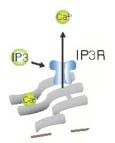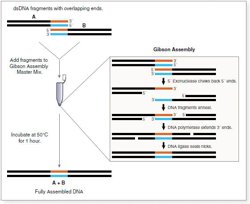Find your product
Advanced searchLogin
Webshop under construction
Due to technical maintenance the webshop is closed until January 3, 4. We wish you a successful 2025!
Welcome
Sign outPersonal information
Tim Vervliet, Prof. Dr. Ir. Geert Bultynck.
Laboratory of Molecular and Cellular Signaling, KU Leuven, 3000 Leuven
The use of Gibson assembly for structure-function analysis of the Inositol 1,4,5-triphosphate receptor family'
Introduction
|
Inositol 1,4,5-triphosphate receptors (IP3Rs) are intracellular channels that mediate calcium release from the endoplasmic reticulum (ER) (Fig. 1). They are activated in response to inositol 1,4,5-trisphosphate (IP3) and play a role in various cell biological and physiological processes, including apoptosis. Excessive Ca2+ transfer from the endoplasmic reticulum to the mitochondria, via IP3Rs, eventually leads to the activation of downstream apoptosis pathways. Our aim is to use mutant IP3Rs and fragments thereof to study the structure-function relationship of the IP3Rs in apoptosis. In this application note we describe the use of the Gibson Assembly™ Master Mix from New England BioLabs (NEB) together with gBlocks™ Gene Fragments from Integrated DNA Technologies (1) for the creation of a basic cloning vector for IP3R research. |
Figure 1: Schematic overview of IP3R Ca2+ transfer |
Inositol 1,4,5-triphosphate receptors (IP3Rs) are intracellular channels that mediate calcium release from the endoplasmic reticulum (ER) (Fig. 1). They are activated in response to inositol 1,4,5-trisphosphate (IP3) and play a role in various cell biological and physiological processes, including apoptosis. Excessive Ca2+ transfer from the endoplasmic reticulum to the mitochondria, via IP3Rs, eventually leads to the activation of downstream apoptosis pathways. Our aim is to use mutant IP3Rs and fragments thereof to study the structure-function relationship of the IP3Rs in apoptosis.
In this application note we describe the use of the Gibson Assembly™ Master Mix from New England BioLabs (NEB) together with gBlocks™ Gene Fragments from Integrated DNA Technologies (1) for the creation of a basic cloning vector for IP3R research.
Gibson Assembly (Fig. 2) is developed by Dr. Daniel Gibson and his colleagues at the J. Craig Venter Institute (2, 3). It allows for successful assembly of multiple DNA fragments, regardless of fragment length or end compatibility. It has been rapidly adopted by the synthetic biology community worldwide due to its ease-of-use, flexibility and suitability for large (up to 300 kb) DNA constructs. In a single reaction a 5’ exonuclease, a DNA polymerase and a DNA ligase assemble multiple overlapping DNA sequences. We used gBlocks™ Gene Fragments as overlapping DNA fragments to construct the modulating domain of the type 1 IP3R. gBlocks™ Gene Fragments are double-stranded, sequence-verified genomic blocks up to 500 bp in length and can be used for easy and cost-effective gene construction or modification.
Methods & Results
The regulatory domain of the type 1 IP3R isoform was assembled in a p3XFLAG-Myc-CMV24 vector. For this purpose 6 gBlocks were created, all 300-400 bp in length, the total insert length was 1800 bp. Overlapping sequences were designed for each gBlock as well as for the outer gBlocks with the vector (Fig. 3). The vector was linearized by using the blunt restriction enzyme EcoRV (NEB, R0101) and subsequently dephosphorylated. Lyophilized gBlocks (10 ng/µl) were reconstituted in TE buffer. Approximately ±0.15 pmol of each gBlock and 0.015 pmol vector, 14 µl in total, was used for the assembly reaction. Fourteen µl Gibson Assembly Master Mix (NEB, E2611) was added and the mixture was incubated at 50°C for 1 hour. This mix was subsequently transformed in high efficiency competent cells and colonies were verified for the complete and correct insert by sequencing. More than 10 colonies were obtained and 10 of those were sequenced in one direction. All 10 were confirmed to have integrated the first 1000 bp of the insert. Three preps were sequenced completely using reverse primers and all 3 verified to contain the complete and correct sequence.

|
Figure 3: Schematic representation of the Gibson Assembly reaction. In red the 6 gBlocks Gene Fragments each 300-400 bp in length. In black the with EcoRV linearized p3XFLAG-Myc-CMV24 vector. |
Summary
We chose Gibson Assembly for this cloning since the construct contained an obstructive restriction site. By using the Gibson Assembly method we could eradicate this site facilitating future clonings. Moreover, the Gibson Assembly method is better capable of handling GC-rich regions then conventional cloning and can be used to introduce several mutations at the same time. This speeds up our line of investigation tremendously. The Gibson Assembly method provided us with an easy to use and reliable method for cloning.
Product Information
| Cat. # | Description | Quantity |
|---|---|---|
| E2611S/L | Gibson Assembly™ Master Mix | 10/50 rxns |
| E5510S | Gibson Assembly™ Cloning Kit | 10 rxns |
| C2987I/H | NEB 5-alpha Competent E. coli (high efficiency) | 6x 0.2 ml / 20x 0.05 ml |
| C2989K | NEB 5-alpha Electrocompetent E. coli | 6x 0.1 ml |
| C3019I/H | NEB 10-beta Competent E. coli (high efficiency) | 6x 0.2 ml / 20x 0.05 ml |
| C3020K | NEB 10-beta Electrocompetent E. coli | 6x 0.1 ml |
References
1 http://eu.idtdna.com/pages/products/genes/gblocks-gene-fragments
2 Gibson, D.G. et al. (2009). Nature Methods, 343-345
3 Gibson, D.G. et al. (2010). Nature Methods, 901-903
Gibson Assembly Benefits
-
Performance
Simplifies complex cloning and vastly outperforms conventional cloning in applications such as in metabolic engineering or synthetic biology.
-
Simplicity
No cloning sites required resulting in scar-less cloning.
-
Fast
Complex cloning in 1 hour.
-
Convenience
No clean up of PCR products required.
-
Versatility
Cloning, Site-Directed Mutagenesis, etc.


